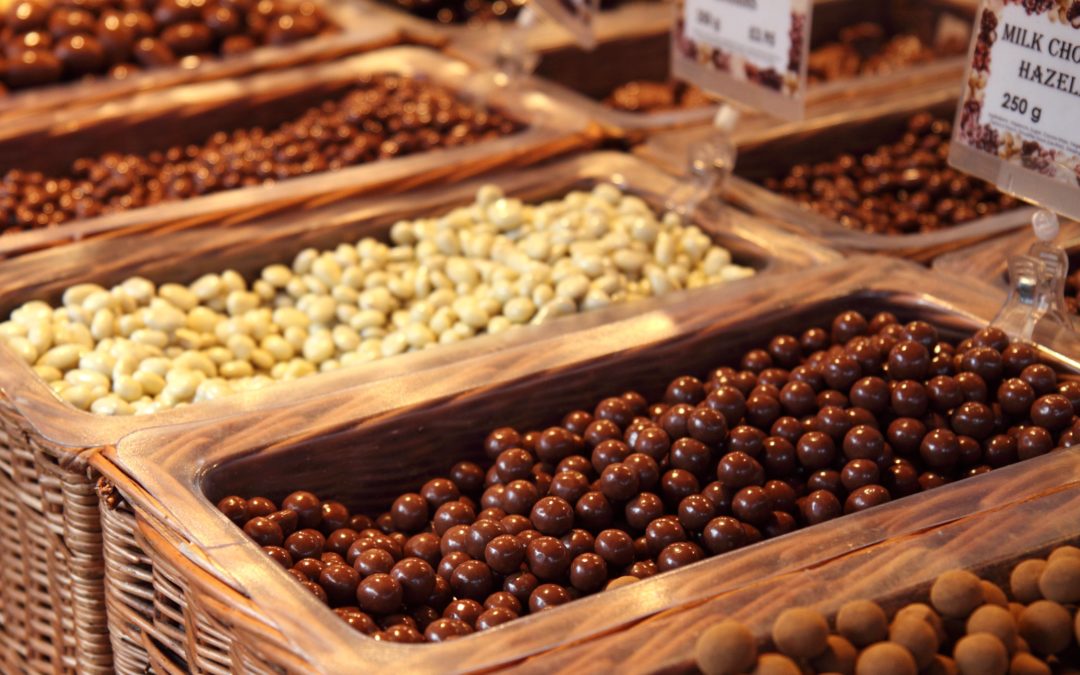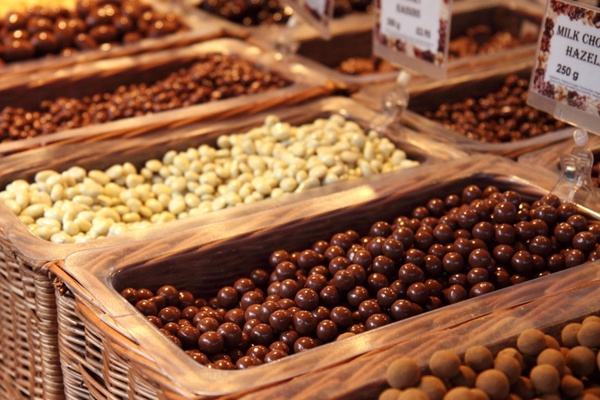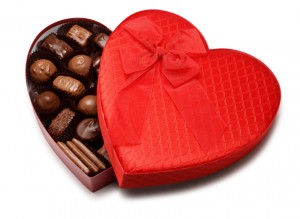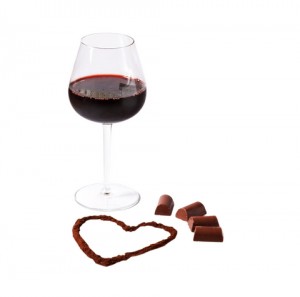
by Lorri | Feb 13, 2019 | UnCorked
Wine and chocolate is a recurring theme on Valentine’s Day. Understandably, considering many of us will be either giving a gift of wine and chocolate or opening a gift of wine and chocolate. Keeping it simple and knowing the most common mistakes will ensure the two complement each other and make your Valentine celebration much more enjoyable.
There are many rules for general wine and food pairing, but with chocolate and wine there are two keys to successful pairings:
The first, when pairing wine and chocolate, the wine should be at least as sweet — if not sweeter — than the chocolate. If the wine is not as sweet as the chocolate many times the pairing will have a slight sour taste.
And second, avoid pairing chocolate with over-oaked red wines or extremely dry styles as these mismatches will likely rob the chocolate of its sweetness and rob wine of its fruitiness. The result is an unpleasant, dry, dusty flavor.
For safe bets pair light-bodied wines with mild-flavored chocolate, and full-bodied wines with darker and more robust chocolate. For example, a delicate Moscato d’Asti matches perfectly with the mellow buttery flavors in many white chocolates. Cabernet sauvignon matches well with many dark chocolates because it has hints of aromatic dark berry, spice and even of chocolate itself.
To make gift buying easy, here are some safe pairings. All you need to do is choose your partner’s favorite style of chocolate and then select value or splurge that fits your budget.
White chocolate with framboise or moscato
THE VALUE
- NV Cupcake Moscato d’Asti, Italy (about $12 retail)
THE SPLURGE
- 2017 Castello Del Poggio DOCG Moscato, Italy (about $19 retail)
Light-bodied milk chocolate with pinot noir or cabernet sauvignon
THE VALUE
- 2016 Block Nine Pinot Noir, California (about $15 retail)
THE SPLURGE
- 2015 Sonoma-Cutrer Russian River Valley Pinot Noir, California (about $29 retail)
Medium bodied milk or semisweet chocolate with cabernet sauvignon, port, merlot or syrah
THE VALUE
- 2017 Chateau St. Jean Merlot, California (about $14 retail)
THE SPLURGE
- 2015 Round Pond Cabernet Sauvignon, California (about $65 retail)
Full-bodied bittersweet or dark chocolate with cabernet sauvignon or port
THE VALUE
- 2017 Coppola Diamond Label Cabernet Sauvignon, California (about $16 retail)
THE SPLURGE
- Kopke 10 Year Tawny Port, Portugal (about $37 retail)

by Lorri | Feb 8, 2017 | UnCorked
Chocolate and wine are linked surprisingly often. Terms used in chocolate tastings often are the same as at a wine tasting: fruity flavors, long lingering finishes and even the mouth-feel and body. Many varieties of cocoa beans have distinct characteristics similar to grape varieties and both products use brewer’s yeast (Saccharomyces cerevisiae) during the fermentation stage.
But pairing wine and chocolate successfully can be difficult. There are a number of factors that lead to unsuccessful matches, but the cause is most often the excessive sugar and fat common in milk chocolate and most mass-produced chocolate. For the ideal pairing opt for dark chocolates and desserts prepared with dark chocolate.
When selecting chocolate, look for the cacao percentage on the label. It generally ranges from 60 percent to 85 percent. The percentage refers to how much actual chocolate, or cacao, the recipe uses. The remainder is sugar and other flavorings. The higher the cacao content, the sharper and more bitter the taste, but the better it will match with wine. Because of this sharp, bitter taste, cacao tends to compete with high tannin wines. Consider fruity wine like merlot, petit syrah or carmenere or any fruit-forward red wine.
Something else to consider is acidity. Wines such as crisp sauvignon blanc, pinot grigio and other high acidity wines are usually not recommended as a chocolate match. On the other hand, Champagne and other sparkling wines are generally high in acidity but are a favorite for many to pair with sweets. If your love is loyal to bubbly and chocolate desserts, consider a demi-sec or sweet Italian sparkling wine for the best match.
A sweet port is by far the most dependable and harmonious partner for chocolate. Because the rule for most desserts is the wine should always be sweeter than the dessert, the two are ideal. Port has an upfront fruitiness that blends with the silky texture of fine chocolate. Because of port’s natural sweetness and acidity it can even fare well with creamier chocolates having the higher sugar and fat.
THE VALUES
- NV Zonin Prosecco, Italy (about $15 retail)
- 2014 McManis Family Vineyards Merlot, California (about $12 retail)
THE SPLURGES
- NV Dow’s Late Bottled Vintage, Portugal (about $25 retail)
- 2014 Robert Mondavi Winery Merlot, California (about $26 retail)
- NV Graham’s 10 Year Old Tawny Port, Portugal (about $45 retail)
- NV Graham’s Six Grapes Porto, Portugal (about $40 retail)
- NV Taylor Fladgate 20 Year Tawny Port, Portugal (about $79 retail)

by Lorri | Oct 14, 2015 | UnCorked
The subject of wine and chocolate is often reserved for Valentine’s Day and other romantic occasions. But over the past few months the question of chocolate’s pairing with wines has come up multiple times. So much so that it is now a two-part section for my students in Food and Wine Pairing class at Little Rock’s Pulaski Technical College’s Culinary Arts and Hospitality program. Wine and chocolate are similar in details.
The production process of chocolate is important because, just as wine has complexity in its birth, so does chocolate. Cacao trees grow in rain forests in a band that spans 20 degrees north and south of the equator.
Fruit pods hang from the trunks of the trees. The beans develop inside the pod and are surrounded by a sweet, white pulp. The pods are harvested by hand, then placed in earth pits, covered with banana leaves and allowed to ferment. Just as with wine, this is the state in which the fruit develops aromas, color and complexities as sugars turn to acid. After a week or so of fermentation the pods are dried, sorted and shipped to a production facility. At the factory, the beans are roasted. During this process, the outer shells crack, revealing the “nibs,” known as the “meat” of the cacao bean. The nib is crushed by mechanical rollers, and the friction causes the nibs to turn into a liquid. It is this stage that determines if the nibs will be made into cocoa (powder) or chocolate (solid).
I find it interesting that a chocolate assessment follows similar guidelines as professional wine tasting.
First the appearance. What is the color: Is it pale or dark, radiant or dull? Assess the colors based on shades ranging from brown to black, white to ivory, and yellow to gold.
Next is texture. The better the quality of chocolate the more distinct the cracking sound when you break it. Place the chocolate close to the ear for more detailed sounds. Examine the edge of the break. Quality chocolate should have a clean break and usually not a crumbly or jagged one.
Followed by aroma. Fine chocolates tend to have a broader range of complexity in aromas. Smell the chocolate: Do you detect notes of milk, honey, flower, caramel, nuts, vanilla, roasted nuts or even herbs?
Of course tasting will complete the process. Take a small piece of chocolate in your mouth. Observe the level of sweetness, fruitiness, earth tones and subtle roasting characteristics. Finer chocolates will melt more slowly, offering a more detailed perception of flavors and characters.
For pairing with milk chocolate:
THE VALUE
- 2014 Chloe Pinot Noir, California (about $12 retail)
The Splurge
- NV Cockburn’s 20 Year Tawny Port, Portugal (about $45 retail)
For pairing with dark chocolate:
THE VALUE
- 2013 Ravenswood Lodi Zinfandel, California (about $14 retail)
THE SPLURGE
- 2013 Keenan Napa Valley Cabernet Sauvignon, California (about $47 retail)
by Lorri | Feb 8, 2012 | UnCorked
 Each year on Valentine’s Day my husband never fails to amaze with me with yet another unique and romantic gift. Compounding the impressiveness of this feat is that my wish list usually doesn’t include roses, candies or even jewelry, it revolves around another love of my life: wine.
Each year on Valentine’s Day my husband never fails to amaze with me with yet another unique and romantic gift. Compounding the impressiveness of this feat is that my wish list usually doesn’t include roses, candies or even jewelry, it revolves around another love of my life: wine.
My Valentine’s Day surprises have included such extravagant gifts as my favorite bottle of wine over dinner and a starry-eyed, wine country getaway to practical but still sassy and colorful wine totes. Each gift is beloved because of the thought put into selecting it. So, if you have a wine enthusiast in your life and are looking for a few gift ideas, consider these suggestions for your valentine.
- Chocolate and wine pairing gift set. One of my favorites is the Wine Lovers Chocolate Tin produced by the San Francisco Chocolate Factory. The collection is a wonderful way for wine lovers to experience the subtleties of wine and chocolate without the work (or risk) of creating pairings from scratch. The tins contain dark chocolates with varying cocoa intensity and are labeled with the grape variety that best complements the chocolate. The chocolates’ cocoa content ranges from 54 percent to 72 percent, and they pair with well-known varietals such as cabernet sauvignon, pinot noir, merlot, syrah and port.
- Chocolate of the Month Club. What’s more romantic than a wine-and-chocolate gift set? Chocolates arrive at your doorstep month after month. The best clubs will provide world-class selections focusing on quality and unique chocolates. Some clubs even boast that their chocolates contain secret bean blends, guarded roasting techniques and even infusions of rare spices and flowers. Most companies allow you as little as a three-month commitment for your gift.
- Chateau Calon Segur, Bordeaux, France. We all have wines reminiscent of a special occasion. For me, next to a bottle of Duckhorn (the wine we enjoyed on our wedding night), the romance of Calon Segur is hard to top. The label of this prestigious property of Saint–Estephe has a heart on it, making it a perfect choice for your valentine. It’s said owner Marquis Nicolas-Alexandre de Segur claimed, “I make wine in Latour and Lafite but my heart is in Calon” as the reason behind the heart on the label.
- Wine Country Getaway. What’s more romantic than a trip to a wine region with the one you love? There are many options and choices ranging from a day trip to Altus, a long weekend in California or a destination vacation to France or Italy. Of course your valentine will love this gift, but you get to enjoy it too.
by Lorri | Feb 9, 2011 | UnCorked
 There was a time when it was said that chocolate and wine shouldn’t be consumed together.
There was a time when it was said that chocolate and wine shouldn’t be consumed together.
Pairing these two romantic treats was avoided because chocolate, like cabbage, raw asparagus and vinegar, has a reputation for misbehaving when wine is involved. But today, with a better understanding of the kinds of chocolate and its components, successful pairings are possible.
What supposedly made the two incompatible was not the chocolate at all, but the sugar, fat and flavorings in it. Considering many chocolate desserts also contain lots of sugar, fruit, dairy or even ice, the dilemma was compounded.
If the wine and chocolate are not compatible, many times a slight sour note will develop on the palate. Overoaked or extremely dry red wine will likely rob the chocolate of sweetness and the wine of its fruitiness, resulting in an unpleasant, dry, dusty flavor.
For the ideal chocolate and wine match, select chocolates with a cocoa content of at least 75 percent.
Light-bodied wines match best with mild-flavored chocolate, and full-bodied wines are best served with darker, more robust chocolate.
If in doubt, the general rule is the wine should be at least as sweet — if not sweeter — than the chocolate.
White chocolate: Framboise or moscato
THE VALUE
- 2009 Martin Weyrich Moscato Allegro, California (about $14 retail)
THE SPLURGE
- 2009 Marco Negri Moscato d’ Asti, Italy (about $22 retail)
Light-bodied milk chocolate: Framboise, pinot noir or cabernet sauvignon
THE VALUE
- 2008 Mark West Central Coast Pinot Noir, California (about $12 retail)
THE SPLURGE
- 2008 Siduri Willamette Valley Pinot Noir, Oregon (about $22 retail)
Medium-bodied milk or semisweet chocolate: cabernet sauvignon, port, merlot or syrah
THE VALUE
- 2009 Cupcake Central Coast Merlot, California (about $10 retail)
THE SPLURGE
- NV Sandeman 10 year Tawny Port, Portugal (about $40 retail)
Full-bodied bittersweet or dark chocolate: cabernet sauvignon or port
THE VALUE
- NV Cowie Wine Cellars Robert’s Port, Arkansas (about $19 retail)
THE SPLURGE
- 2006 Robert Mondavi Oakville Cabernet Sauvignon, California (about $50 retail)




 There was a time when it was said that chocolate and wine shouldn’t be consumed together.
There was a time when it was said that chocolate and wine shouldn’t be consumed together.